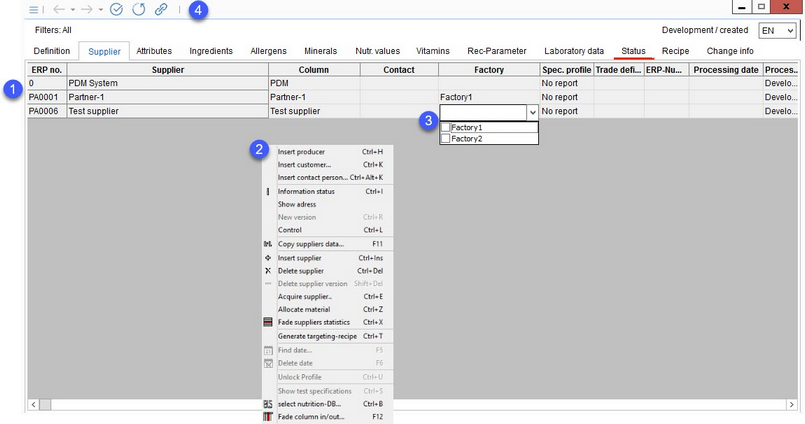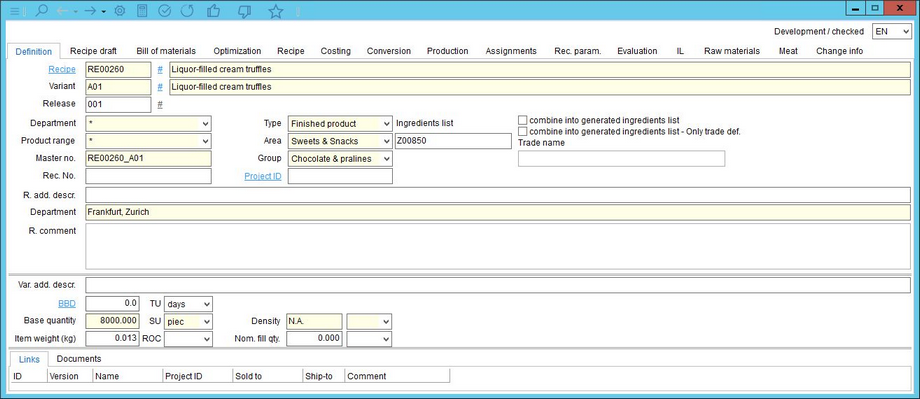Master data may include one or more suppliers, and if they do not match, a producer can also be assigned. Any number of (unique) suppliers, including producers, can be added for the same object. Product data provided by the suppliers are then managed in the other Master data tabs.
There is always one zero supplier present that is used for collecting data from the other suppliers. Data from this zero supplier will be applied once the Master data object is used as a recipe component. For more information, see Master data/Functions & Processes/Copy Supplier Data.
1.Suppliers (including the zero supplier). The following fields are available:
ERP. no.: The internal number of the supplier record from Administration/General/Partner structure.
Supplier: The name of the supplier. Clicking on the supplier name will display a pop-up containing the supplier's SAP number and a hierarchy of its related partners. For example, if the chosen supplier is a plant for a parent factory, the parent factory and second level factory will display. These IDs can be searched for and exported to an Excel sheet in the Search module.

Column: The alternative name of the supplier. This can be defined in Administration/General/Partner structure in the Alias field.
Contact: The assigned contact person. The contact is linked to the supplier. Contact persons can be created for individual partners via Administration/General/Person. A default contact person can be selected using a designated program parameter.
Spec. profile: The specification profile used for reporting. This is the default profile which will automatically be invoked from the WebReporting tool. Behavior of this selection list can be further specified during program installation. The default reporting profile in SpecPDM can either be the last one used by the user, or the one selected in this column.
Trade definition: The recipe name or Recipe variety name. It can be assigned automatically but also filled in manually. This field is used for example when working with nutrient databases.
ERP number: The manually inserted ERP number. This may be the reference ID from the supplier.
Processing date: To enter the processing date, the user has to right-click directly in this field and select Enter date.
Processing status, Status of finding, Date of finding, Finding release, Person responsible for finding: Refers to the control dialog of the supplier record.
Manufacturer: Identical to supplier by default. Suppliers can have one or more manufacturers (production sites or broker scenario).
Customers: The assigned customers.
Remarks: A manually entered comment.
Test specifications: Indicates the existence of an inspection plan for this record. Right-click → Show test specification redirects to the Inspection plan module.
Supplier state: The supplier status. Define the actual status of individual suppliers. The user can opt for ancillary or main supplier, the main supplier is highlighted blue.
Released: Indicates whether supplier was released (zero partner is always released).
Portal: The checkbox should be selected if a portal (Supplier's Guide) supplier exists.
Template: Select an existing portal template to connect to Supplier's Guide. See Administration/General/Templates Manager for more information.
Owner: Use the dropdown list to select a company that is responsible for the material that is used by different factories. Only one company can be chosen for each supplier - this company, or "owner," is the umbrella company which the individual factories fall under. In conjunction with the Supplier's Guide, the company assigned to this column can be uploaded to the Supplier's Guide as the sole issuer of that specification.
Origin, Date, Person: The linked source record from Recipe assignment. Date and person refers to last "commit to Master data" performed.
Risk: The risk class indication.
2.A right-click in the Supplier tab opens a context menu with the following options:

Insert producer: Opens the Select manufacturer dialog. For more information see Assign supplier - Insert producer.
Insert customer: Opens the Select customer dialog. For more information see Assign supplier - Insert customer.
Insert contact person: Opens the Definition - person dialog. For more information see Assign supplier - Insert contact person.
![]() Information status: Opens the Status overview dialog. This dialog contains all change information for the selected supplier.
Information status: Opens the Status overview dialog. This dialog contains all change information for the selected supplier.
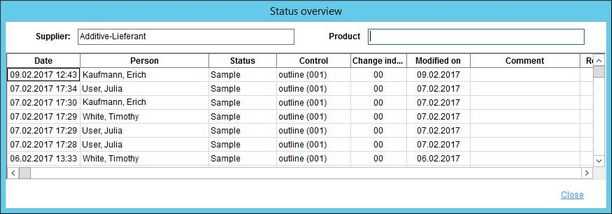
Show address: Opens the Administration/General/Partner structure dialog with the contact details of the supplier. An appropriate department must be selected, otherwise the entry will not be displayed.

New version: Here, a new supplier version can be created. Using the version # button in the Definition tab, you create a new version of the object only for the zero partner. For other partners, use the following procedure: Use the Control dialog (see the following image) and select the specific Partner to create the new version for. Then use the control status to release the object (new version can be created only for objects with statuses Released and Inactive). Then back in the Partner tab right-click on the partner to open the context menu and select New version.
Control: Control of supplier version. For more information, see General Information/Data/documents control.
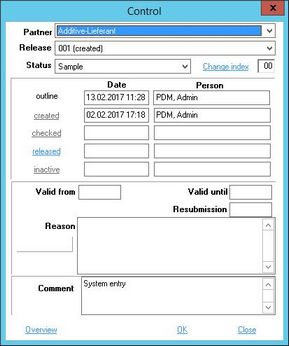
|
Copy supplier data: Enables transferring the selected type of Master data from one supplier to another. For instructions on how to use this function, please see Master data/Functions & Processes/Copy Supplier Data. |
|
Insert supplier: Opens the Select supplier dialog. For more information, see Assign supplier. |
|
Delete supplier: Deletes the selected supplier with all their Master data. The following warning message will appear: |
|
|
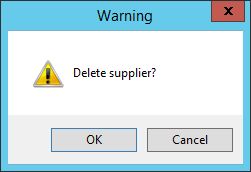
|
Delete supplier version: A supplier version can be deleted if there is more than one version and is in an active state (released, inactivated, reactivated). |
|
Acquire supplier: A shortcut to Administration/General/Partner structure, where a new supplier can be created. |
|
Allocate material: Opens the Allocation supplier - material dialog. Here, a product structure can be associated with the supplier. |
|
Fade supplier statistics: Suppliers with statuses defined in this dialog will not be displayed. |
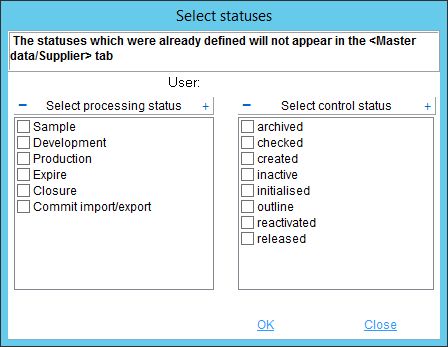
Generate targeting recipe: Quickly create a recipe from the Master data. Opens the Recipe/Definition dialog with all the data prefilled.
More information can be found in the Recipe section.
|
Find date: Works only if you right-click the Processing date column. A processing date can be specified for each supplier. |
|
Delete date: Deletes the processing date. |
|
Unlock profile: Works only in the Spec. profile column. Enables the selection of a specification profile for already released supplier. |
|
Show test specifications: Opens the Specification dialog if an inspection plan specification is available. |
|
Select nutrition DB: See Assign BLS Supplier. |
|
Fade column in/out: To show or hide columns. It is also possible to rename columns by double-clicking their name. |
3.Factory selection list: A dropdown selection list in this column allows the user to specify which factories are associated with the supplier. Multiple factories can be chosen for one supplier.
4.Quick access toolbar: For more information, see Master data/Functions & Processes/Basic Master data Functions.
